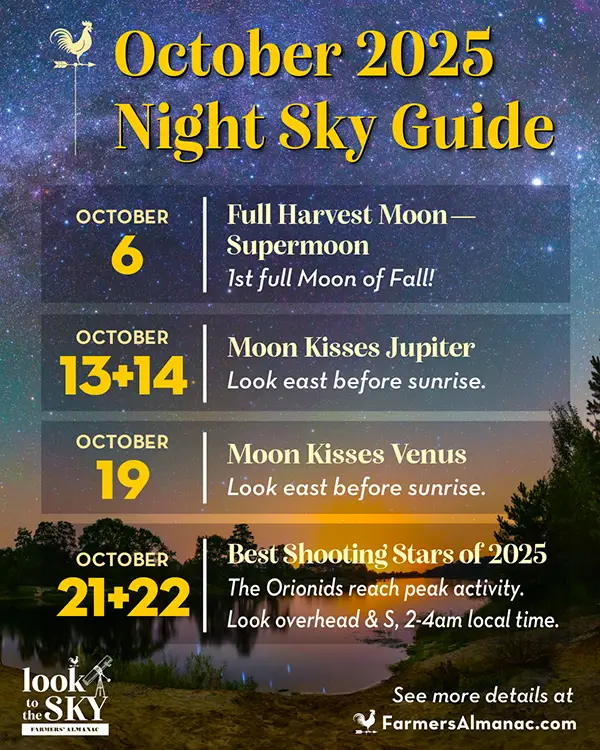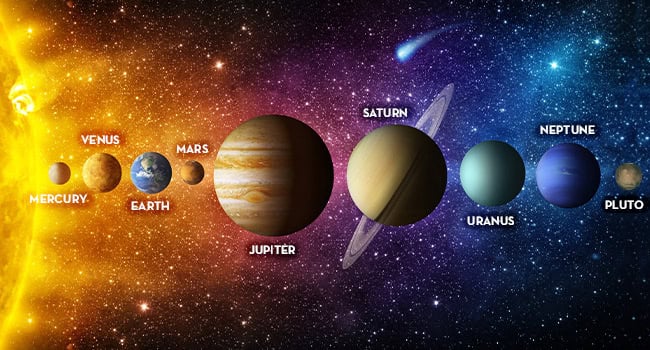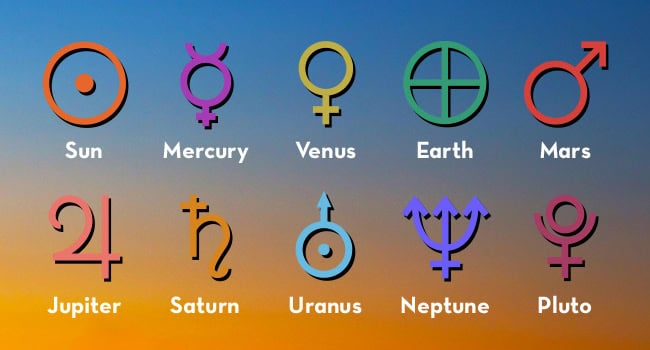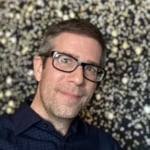Ever look at the Moon and see a bright star shining beside it? Chances are it’s a planet (usually Venus or Jupiter). Farmers’ Almanac teams up with expert astronomer Dean Regas for this go-to guide to tell you which visible planets are shining tonight (or tomorrow morning) and which direction to look.
Visible Planets 2025
Spot the five naked-eye planets: Mercury, Venus, Mars, Jupiter, and Saturn—no telescope needed! We also explain how to see Uranus and Neptune through a telescope. (What about Pluto? This dwarf planet is tough to see, but if you’d like to learn more about it let us know.) Bookmark this page and refer to it throughout the year!
This monthly listing of the visible planets, viewing directions, and special sky events is followed by more information about each planet.

October 2025
Mercury: Look southwest just after sunset October 18-28.
Venus: Look east and southeast just before sunrise all month (until November 20).
Mars: Too faint to see.
Jupiter: Look east before sunrise all month.
Saturn: Look southeast after sunset all month.
Uranus: Look south before sunrise all month.
Neptune: Look southeast after midnight and west two hours before sunrise all month.
Any questions? Contact [email protected]
November 2025
Mercury: Look southeast just before sunrise November 28-30.
Venus: Look east and southeast just before sunrise November 1-20.
Mars: Too faint to see.
Jupiter: Look east before sunrise all month.
Saturn: Look southeast after sunset all month.
Uranus: Look west before sunrise November 1-25.
Neptune: Look southeast after sunset all month.
December 2025
Mercury: Look southeast just before sunrise December 1-25.
Venus: Not visible in December 2025.
Mars: Too faint to see.
Jupiter: Look east before sunrise all month.
Saturn: Look south after sunset all month.
Uranus: Look east after sunset all month.
Neptune: Look south after sunset all month.
The Planets In Order
Did you ever recite the old phrase, “My very educated mother just served us nachos?” That saying can help you remember the order of the planets from closest to farthest from the Sun: Mercury, Venus, Earth, Mars, Jupiter, Saturn, Uranus, Neptune. The first letter of each word is the first letter of each planet.

More About Each Planet
For easy reference, we included each planet’s specific viewing date ranges, times, and directions here—as well as more information. If you have any questions or would otherwise like more information, please tell us in the comments. Your questions will be answered by our expert astronomers.
Mercury: The Elusive Planet
When is Mercury visible in 2025?
- Visible for a brief time at the end of February 2025. See details.
- March 5-12, 2025: Look west just after sunset.
- April 15-25, 2025: Look east just before sunrise.
- June 18-July 6, 2025: Look west just after sunset.
- August 15-29, 2025: Look east just before sunrise.
- October 18-28, 2025: Look southwest just after sunset.
- November 28-December 25, 2025: Look southeast just before sunrise.
Mercury is the most elusive planet and is the toughest of the five naked eye planets to find in the night sky. It moves quickly from night to night, and it shifts from being visible in the morning sky to the evening sky in a matter of weeks.
In Roman mythology, Mercury was associated with the swift, fleet-footed messenger god. The planet lives up to the reputation of its namesake as the fastest planet, whipping around the Sun at an average speed of almost 106,000 miles per hour.
The main problem with finding Mercury is that it orbits very close to the Sun. That means Mercury is most often up in the sky at the same time as the Sun.
The only time you can find Mercury is when it appears farthest from the Sun (astronomers call this position of a planet its greatest elongation) while the Sun is still below the horizon.
To see Mercury when it is at its greatest eastern elongation, you will want to look to the western sky 15 minutes after sunset. It will be low in the sky, so you will need a clear view of the western horizon free from buildings or trees. As the sky darkens, search for a steady, semi-bright light glowing through the twilight. It will be about as bright as the brightest nighttime stars.
To observe Mercury in the morning sky, you will have to wait for its greatest western elongation. When this occurs, look low above the eastern horizon 45 minutes before sunrise. Over the next 30 minutes you might see pinkish Mercury pop into view just before the Sun pokes above the horizon.
Venus: The Dazzling Planet
When is Venus visible in 2025?
- Look for Venus as the Evening Star visible low in the southwest after sunset August 2024-March 2025.
- Venus will be invisible to us as it travels in front of the Sun at the end of March 2025. But then it will pop out as the “Morning Star” from April 1-November 20, 2025, and be visible in the east and southeast just before sunrise.
Venus was the goddess of beauty in ancient Rome. When the planet Venus is in the sky just after sunset as the “Evening Star” or just before sunrise as the “Morning Star,” you cannot miss her. When Venus shines, she looks like an extraterrestrial visitor has graced the heavens.
Venus is the brightest planet in the nighttime sky. It is so dazzlingly bright because it is relatively close to Earth and because a thick blanket of clouds perpetually covers its surface. These clouds reflect so much sunlight into space that from Earth only the Sun and Moon shine brighter than Venus.
Like Mercury, Venus can best be seen just before sunrise or just after sunset, depending on where it is in its orbit. Some stargazers call Venus the Morning Star or Evening Star, depending on when it is visible. Venus looks especially good when it is near a waxing crescent Moon in the fading twilight of evening, or when it cozies up to a waning crescent Moon just before dawn.
After the Moon, Venus is the brightest natural object in the night sky. It is both the Earth’s closest neighbor in our Solar System and the planet most similar to Earth in size, gravity, and composition. We can’t see the surface of Venus from Earth, because it is covered with thick clouds. Venus has the densest atmosphere of the four terrestrial planets (Mercury, Venus, Earth, and Mars), which consists mostly of carbon dioxide. Always brilliant, and shining with a steady, silvery light.
Mars: The Red Planet
When is Mars visible in 2025?
- Mars reaches its closest point to Earth in mid-January 2025. That means it rises in the east as the Sun sets in the west all month. Mars will remain visible in the evening sky from January until September (but will be very faint in August and September). You will have lots of time to get to know the Red Planet in 2025. Late in the year, Mars will be behind the Sun, only to emerge in the morning sky in March 2026.
Mars is easy to find in the night sky with the naked eye because of its distinctive color. It is nicknamed the Red Planet because it shines with an extremely off-white light. When you find it, you might classify its hue as orange or yellow instead of red, but when you compare its light to that of white or blue stars, you will see it is redder than most. This bloody color led ancient Romans to associate this planet with Mars, their god of war.
In the sky Mars appears brighter than the brightest stars that are visible from even urban locations. Mars is best viewed when it is closest to the Earth, and thus appears at its biggest and brightest in the evening sky. The Red Planet’s distance from us varies significantly: from almost 250 million miles at its farthest to about 35 million miles at its closest.
Astronomers use the term opposition to describe the moment when Mars and Earth get closest together as they orbit the Sun. Opposition occurs when the Earth is between Mars and the Sun, placing the Sun on the opposite side of the sky from Mars. This alignment happens about every 26 months.

Jupiter: The Steady Planet
When is Jupiter visible in 2025?
- As 2025 begins you’ll easily spot Jupiter in the southeastern sky after sunset. Night after night the giant planet will slowly shift westward being visible in the night sky through about June 1. After spending about six weeks behind the Sun, Jupiter will pop out into the morning sky being visible before sunrise from late July through the rest of 2025.
Ancients Greeks called this planet Zeus, and the Romans adopted this bright night light as the manifestation of their chief god, Jupiter.
Jupiter is an unmistakable light in the night sky. It appears to be a non-twinkling cream-colored star and is very often the brightest starlike object in the entire night sky. Jupiter’s brilliance is so stunning that it is often more than twice as bright as the brightest star in the sky, Sirius. When Jupiter is in the sky, you notice it!
Jupiter is a steady performer. Unlike Mercury or Mars, the light it shines on Earth does not fluctuate very noticeably in brightness over the time it is visible in the night sky. Even though Jupiter is far from Earth (roughly 400 million miles), it is so large and its cloud tops reflect so much sunlight that it shines brightly whenever it is up in the sky.
Jupiter will be closest to the Earth (and brightest) during its next opposition, in December 7, 2024.
Saturn: The Slow Planet With A Secret
When is Saturn visible in 2025?
- Saturn begins the year hanging on the southwestern sky, visible as a pale yellow star just after sunset in January and the first half of February. You’ll start to notice Saturn again in the predawn sky starting around mid-April 2025. At the end of September, it will be more noticeable in the evening sky again. From October through the end of the year, the ringed planet will be easy to find after dark.
Saturn is the slowest-moving of the naked-eye planets. The ancient Romans noticed this sluggish motion and incorporated it into their mythology. Saturn was often depicted as an old man with a long beard and later was equated with the figure of Father Time.
The farthest planet you can see with the naked eye, from even suburban locations, is Saturn. Although you cannot detect the ridiculously cool rings of this planet without a telescope, you can still easily locate it every year in the night sky.
Saturn appears to be a non-twinkling yellow star that shines with a light equal to or sometimes greater than the brightest first magnitude stars like Vega and Arcturus. Like all planets farther from the Sun than Earth, Saturn appears biggest and brightest near opposition. At opposition Saturn is still over 800 million miles away, but it is so large and its surface and rings reflect so much sunlight that it shines like a first magnitude star.
Uranus, Neptune, Pluto, and Others
To find the other planets, Uranus and Neptune, you will need a telescope. Uranus can be spotted with a pair of binoculars, but it will only look like a tiny pinpoint of light. Through a telescope, Uranus will appear as a pale blue-white circle of light. While Neptune, even through a large telescope, will only look like a tiny blue dot.
When is Uranus visible in 2025?
- Uranus is visible in the evening sky from January 2025 until mid-April 2025. Then Uranus will appear in the morning sky from July-September 2025. Look for it back in the evening sky October-December 2025.
When is Neptune visible in 2025?
- The farthest planet dwells in the evening sky January and February before hiding behind the Sun. Neptune sneaks into the morning sky appearing before sunrise May-July 2025. Then look with a telescope to find Neptune in the evening skies August-December.
How about Pluto?
Pluto, which was reclassified as a dwarf-planet (as opposed to a planet) in 2006, is almost impossible to observe in a backyard telescope. Even through a professional telescope, Pluto looks fainter than most of the faintest stars around it. Several asteroids would make easier targets such as Ceres and Vesta which are significantly closer to Earth and shine many times brighter than Pluto. But none of these former planets can be found with the naked eye.
Visible Planets with Moon Pairings
People often notice a planet when it appears near the Moon. They will ask, “what was that bright ‘star’ next to the Moon last night?” The Moon and planets seem to traverse a ring around the Earth called the zodiac. These are the stars in the famous zodiac constellations like Aries, Virgo, and Sagittarius. The Moon monthly passes through all twelve zodiac constellations while the planets move through them at various, slower speeds. But each month, the Moon will appear to pass near each planet. When it does it is called a conjunction.
The most picturesque pairing is when the crescent Moon shines next to the brightest planet, Venus. Here at Farmers’ Almanac we refer to this as The Moon “kissing” Venus. Pairings of Jupiter and the Moon are a close second! Here are upcoming dates for each:
The Moon Kisses Venus
The Moon kisses Venus (Moon-Venus conjunctions) in the evening sky on the following dates in 2025:
- January 3, 2025.
- February 1, 2025.
- March 1, 2025.
The Moon kisses Venus (Moon-Venus conjunctions) in the morning sky, before sunrise, on the following dates in 2025:
- August 20, 2025.
- September 19, 2025: Best one. They will be only ⅓ degree apart.
- October 19, 2025.
The Moon Kisses Jupiter
The Moon kisses Jupiter (Moon-Jupiter conjunctions) in the evening sky, after sunset on the following dates in 2025:
- January 10, 2025
- February 6, 2025
- March 5 and 6, 2025
- April 2, 2025
- April 30, 2025
- May 28, 2025
- December 6 and 7, 2025
The Moon kisses Jupiter (Moon-Jupiter conjunctions) in the morning sky, before sunrise on the following dates in 2025:
- July 23, 2025
- August 19, 2025
- September 16, 2025
- October 13 and 14, 2025
- November 9, 2025 (around midnight)
Kissing Planets
Two or more visible planets can often appear to line up as seen from Earth. Planetary alignments of two, three, four, or even five planets are some of the most amazing sights to see in the night sky.
Here is a planet pairing to watch for in 2025:
- January 17: Venus-Saturn conjunction (evening sky)
- April 2: Moon-Jupiter conjunction (evening sky)
- April 25: Venus-Saturn-Mercury-Moon conjunction (morning sky)
- July 16: Saturn-Neptune-Moon conjunction (after midnight)
- August 11-13: Venus-Jupiter Conjunction (morning sky)
Join the Discussion
If this article inspires you to go outside and look for planets in the night sky for the first time, let us know what you find.
We love hearing from you!









I am visiting in Faro, Portugal and my hotel room window looks westward. After sunset, Jupiter is clearly visible but I could swear that I saw five different planets come together last night, in one of the most spectacular views in my lifetime. It did not last long but what remained afterwards appeared to be Jupiter and Saturn. In one photo, I can see the rings of Saturn which are not normally visible to the human eye. Can you shed some light on this amazing experience in this photo.
Is this Mercury?
I enjoyed your article. It educated me on the fact that the photos I took were of the Cresent moon and Venus.
Thank you! What a great photo!
Really fun I hope I can be added to your list
I want to know where and which direction
Great article
I enjoy watching the planets with my uncle. He work for NASA for 20 yrs. He tell me joke why the people’s behind the chair in NASA think about. The answer was kind of funny wait for the next break time. Also what they is eat green crackers with green cheese to think that they are on Mars. I enjoy learning more about the planets with uncle. Than listening to crazy joke
Isaiah 40:22 talks about the circle of the earth, so even people back then believed that the earth was round like a ball.
Agreed
If the earth is flat why can’t we go to the ends of it? The sides ? And how do you explain photos taken from outer space that show earth as a round planet ?? I’m baffled that people defy facts . Science is the truth whether you believe in it or not .
I am wanting to make a project on travel from earth to Venus planet.
So, Venus is practicaly visible entire year!? Ok, how is that possible? If it is closer to Sun then Earth, that means it can be visible ONLY during the day and ONLY part of the year,since it sits between us and the Sun. You can not observe it during the night, since we are facing outer space on the night side and Venus is simply not there. This is why I KNOW Earth is not a globe. Same goes for Mercury…
i would have to say that *visible* entire year means it can be seen daily….i live in georgia and i’ve been seeing Venus every evening all summer…..i saw it a few times in the morning during the beginning of the year…..but sunrise is a foreign concept to me ☺ so my star gazing is night time….been seeing Saturn and Jupiter for months now south of up after midnight……love the night sky…..i pray for CME’s in the hopes of seeing the aurora!!!!
Straka, How does earth being flat change any of that? Venus is only visible “at night” in the evening relatively close to the horizon just after the sun sets because we need to look “almost” in the same direction as the sun. Same in the mornings depending on the time of year. That’s because as you noted Venus is in orbit closer to the sun. Wow, the earth is a sphere. Just like the rest of the planets and moons and every other large celestial body.
Wow. So let me get this straight, you actually think the earth is flat?!!
You need to go back to elementary school dude.
This is what is wrong with our country, thinking like that and being ignorant about proven facts.
I bet if you even voted, you voted for the biggest ignorant choice, traitor trump. Unreal. Please educate yourself
Vernie, at first you have to wipe away some stereotypes yourself and then, after all, impose your false ideas about the structure of our planet on anyone. “Proven facts” is the bait for such gullible people as you are. Our consciousness is kept captive by those who don’t want us to know real state of affairs. It’s easier for them to control your mind. Wake up and never consider someone to be ignorent and not educated. It might happen that you are far away behind our reality.
The earth is observably round. I find it funny that flat earthers never truly look at what they talk about.
Be nice.
Be nice.
Flat=Earthers can only be 2 things. 1. a Joker, who thinks his ridiculous claims are so hilarious that he must laugh at those around him shaking their heads. or 2. a Fool, who actually believes the unfounded and wholly inaccurate contention of this particular idiocy.
You really don’t know what you are talking about. Venus is always seen as a crescent before the dawn in the eastern sky or after sunset in the western sky, when it can be seen. It is always a crescent because it is closer to the sun so we can only see it when it is to the side of the sun so it will never be seen full like the moon.
You only see it before dawn or after sunset depending on where it’s orbit is in relation to our orbit.
I suggest you by a cheap telescope and look at what you are commenting on before you comment. You will be amazed at the true beauty of God’s never ending creation.
Relax I think they made an intelligent observation and sure, you make sense, so ok maybe earth is a ball, and sure earth being flat wouldn’t help it being closer to the sun yet seen in darkness somehow but what you say makes sense. For a god believer you don’t think god could make a flat earth? You think god appreciates how rude you are? Why don’t you think twice before you comment. Flat earth can still be beautiful anyways wtf
Love your thinking! Hell yeah makes sense to me too! Funny how typical that other moron is bashing you for using your head and making a logical conclusion even if it wasn’t taught to you in school. Lollll sillies be silly. Beagle mom makes a good point tho I do remember hearing Venus is the morning star. Feel like I’ve seen it at night myself though.
please stop deceiving to yourself you are missing out on so much knowledge by not putting the time in to understand what you don’t. I say this with sincerity and respect.